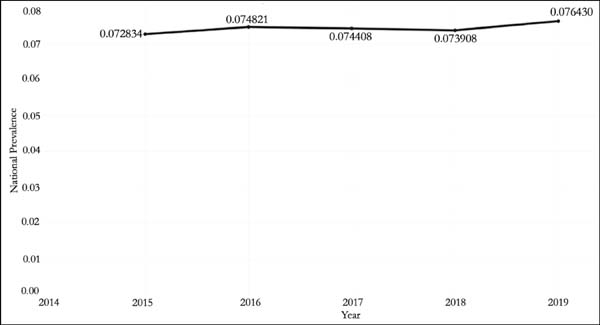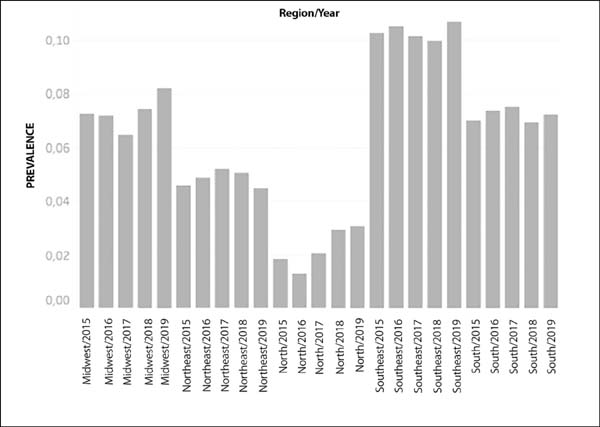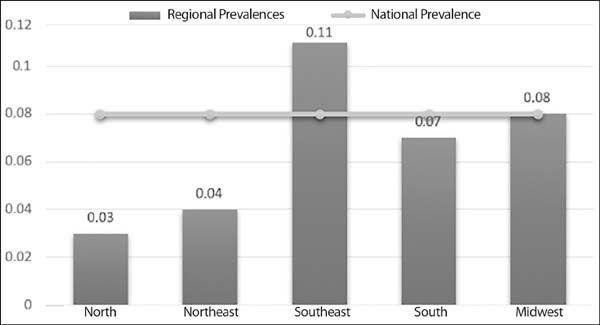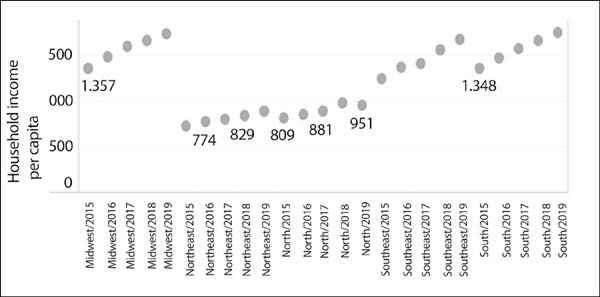INTRODUCTION
According to the census conducted by the Sociedade Brasileira de Cirurgia Plástica in 2018, breast reduction surgery is one of the five most performed cosmetic surgeries
in Brazil1. This surgery aims to reduce breast volume in cases of breast hypertrophy to maintain
symmetry and have a minimum number of complications2.
Breast hypertrophy is a condition characterized by gradual breast enlargement beyond
anatomical limits when in the absence of other causative conditions such as pregnancy,
tumors, hemorrhages, among others3. Back pain, dermatological changes in the mammary grooves and shoulders, postural
vices, breast tenderness, and psychological, aesthetic, and functional impairment
are some morbidity factors commonly associated with this pathology4-6. In this sense, female reduction mammoplasty has a function beyond aesthetics since
it restores the physiological volume of the breasts, significantly impacting the patient's
quality of life with gigantomastia7.
Although reducing mammoplasty is one of the most common surgeries in the daily life
of plastic surgeons, Brazil still lacks analytical studies conducted on a population
basis. Therefore, the epidemiological data available on this procedure are still limited
in the literature.
OBJECTIVES
The present study aims to describe the prevalence of reducing mammoplasty in Brazil
from 2015 to 2019. Furthermore, as secondary objectives, the study aims to compare
the prevalence of reducing mammoplasty between the regions of Brazil from 2015-2018
with the year 2019, in addition to evaluating the relationship between regional family
income and the prevalence of female reducing mammoplasty in the country of 2015-2019.
METHODS
This is a retrospective ecological study, carried out from data provided by the Informatics
Department of the Unified Health System (DATASUS) originated from the "Hospital Production
Authorization" (AIH). The AIH is a mandatory filling document for the medical team
responsible at the time of hospitalization. Electronic data collection was performed
between July and August 2020.
The variables of interest selected for the study were: the total number of hospitalizations
and the estimated female population. Each of these variables was collected by region/federative
unit from 2015 to 2019, including hospital units from all legal spheres (public administration,
business entities and non-profit entities). Therefore, both hospitalization regimes
(public and private). In addition, estimates of average household income per capita
were obtained through the Brazilian Institute of Geography and Statistics (IBGE) demographic
censuses.
Exploratory analyses of the numerical variables collected were performed, which were
described in absolute simple frequencies. Prevalence calculation was obtained by dividing
the total number of hospitalizations multiplied by 1,000 by the estimated female population.
For comparison between the variables, the Student's t-test and Pearson's correlation
were used. A statistically significant p<0.05 value was considered. The data was organized
into charts and tables through the SPSS program (Version 25, SPSS Inc., Chicago, Illinois,
USA) and Tableau Public© (2020 Tableau Software, LLC, Salesforce Company).
Because it is a public domain database, the present study dispenses with the need
to submit the project to the ethics and research committee.
RESULTS
The prevalence of reducing mammoplasty in Brazil in 2019 was 0.08%, while in 2015
to 2018, this prevalence was 0.07%, demonstrating similar values over the last five
years (Figure 1).
Figure 1 - National prevalence of female reduction mammoplasty (2015-2019).
Figure 1 - National prevalence of female reduction mammoplasty (2015-2019).
The Brazilian region with the highest prevalence of female reduction mammoplasty in
the period was the Southeast, with prevalence of 0.10% (2015), 0.11% (2016), 0.10%
(2017), 0.10% (2018) and 0.11% (2019), which exceeded the national prevalence for
the same year under analysis. In contrast, the region with the lowest prevalence of
this procedure was the North, which was: 0.02% (2015), 0.01% (2016), 0.02% (2017),
0.03% (2018), and 0.03% (2019), significantly lower than the prevalence observed nationally.
The prevalence of all regions of Brazil, broken down by year, is explained in Figure 2.
Figure 2 - Prevalence of reducing mammoplasty in regions of Brazil from 2015 to 2019 by region/year.
Figure 2 - Prevalence of reducing mammoplasty in regions of Brazil from 2015 to 2019 by region/year.
In 2019, when the Brazilian prevalence of reducing mammoplasty was 0.08%, the Southeast
region exceeded this, with a prevalence of 0.11%; the Midwest region presented a prevalence
coincident with the national region, while the other Brazilian regions did present
lower prevalence (Figure 3).
Figure 3 - National prevalence of female reduction mammoplasty.
Figure 3 - National prevalence of female reduction mammoplasty.
There was no statistically significant difference compared to the regional prevalence
from 2015 to 2018 with the prevalence of 2019, demonstrating that the Brazilian prevalence
of reducing mammoplasty presents a stable temporal trend over the years (p=0.79; p=0.82;
p=0.82; p=0.89, respectively) (Table1).
Table 1 - Comparison between regional prevalence for 2015, 2016, 2017 and 2018 with regional
prevalence for 2019.
| Regions |
Prevalence/2019 |
Prevalence/2015 |
p |
| North |
0.03 |
0.02 |
0.79 |
| Northeast |
0.04 |
0.05 |
|
| Southeast |
0.11 |
0.10 |
|
| South |
0.07 |
0.07 |
|
| Midwest |
0.08 |
0.07 |
|
| Regions |
Prevalence/2019 |
Prevalence/2016 |
p |
| North |
0.03 |
0.01 |
0.82 |
| Northeast |
0.04 |
0.05 |
|
| Southeast |
0.11 |
0.11 |
|
| South |
0.07 |
0.07 |
|
| Midwest |
0.08 |
0.07 |
|
| Regions |
Prevalence/2019 |
Prevalence/2017 |
p |
| North |
0.03 |
0.02 |
0.82 |
| Northeast |
0.04 |
0.05 |
|
| Southeast |
0.11 |
0.10 |
|
| South |
0.07 |
0.08 |
|
| Midwest |
0.08 |
0.06 |
|
| Regions |
Prevalence/2019 |
Prevalence/2018 |
p |
| North |
0.03 |
0.03 |
0.89 |
| Northeast |
0.04 |
0.05 |
|
| Southeast |
0.11 |
0.10 |
|
| South |
0.07 |
0.07 |
|
| Midwest |
0.08 |
0.07 |
|
Table 1 - Comparison between regional prevalence for 2015, 2016, 2017 and 2018 with regional
prevalence for 2019.
The average household income per capita is described by region/year in Table 2, and this data was graphically demonstrated in Figure 4. The prevalence of reducing mammoplasty in the regions of Brazil over five years
(2015-2019) showed a moderate positive correlation with mean household income per
capita (r=0.74).
Table 2 - Average household income per capita per region/year.
| Regions |
2015 |
2016 |
2017 |
2018 |
2019 |
| North |
809.00 |
845.86 |
881.43 |
968.86 |
950.71 |
| Northeast |
716.89 |
774.11 |
794.44 |
829.22 |
887.22 |
| Southeast |
1,242.00 |
1369.25 |
1396.50 |
1551.00 |
1665.75 |
| South |
1347.67 |
1470.00 |
1568.00 |
1657.33 |
1744.33 |
| Midwest |
1357.25 |
1478.25 |
1590.75 |
1652.00 |
1727.25 |
Table 2 - Average household income per capita per region/year.
Figure 4 - Average per capita family income from 2015 to 2019 by region/year.
Figure 4 - Average per capita family income from 2015 to 2019 by region/year.
DISCUSSION
This is the first national study to describe the national and regional prevalence
of female reduction mammoplasty in Brazil. This procedure is well addressed in the
literature regarding the technique employed 2,5, post-surgical outcomes8,9 and impact on quality of life 4.10 of patients after mammoplasty, but still lacks epidemiological population data.
The analysis of the results demonstrated in the national and regional prevalence graph
of reducing mammoplasty (2015-2019) (Figure 1 and Table 1) allows us to observe temporal stability concerning the prevalence of reducing mammoplasty
in Brazil (p=0.79; p=0.82; p=0.82; p=0.89 for the comparison of regional prevalence
for 2015-2018 with the 2019 regional prevalence). Furthermore, this stability was
also found in the census conducted by the Sociedade Brasileira de Cirurgia Plástica (SBCP), which showed that, in 2014, reducing mammoplasty represented 11.7% of all
cosmetic surgeries performed that year, with this number falling to 9.6% in 2016 and
in the last census conducted in 2018 it was 9.9%.
This slight variation in the rate may have a relationship with the per capita income
of the Brazilian population, which between 2016 and 2018 ranged from R$ 1,187 to R$1,326
(Table 2). The per capita income of the population can be closely related to the prevalence
of aesthetic procedures in general, since in 2018, for example, 61% of plastic surgeries
performed were of a private nature, with 18% derived from a health insurance and only
2% from SUS1. In the Unified Health System, mammoplasty is only possible in cases of patients
with breast hypertrophy. In the Unified Health System, mammoplasty is only possible
in patients who have breast hypertrophy or asymmetry. These will result in functional
changes, such as chronic back pain, pain or skin lesion in the shoulders, postural
disorders, dermatitis, or changes in the spine11.
In addition, the National Agency for Supplementary Health (ANS) issued a technical
opinion in 2019. It stated that the procedure for correcting mammary hypertrophy is
not included in the list of procedures and events in health. Furthermore, it does
not have mandatory coverage by health plans12. Therefore, reducing mammoplasty is an inaccessible procedure for most of the population.
This small accessibility to breast reduction surgery is also perceived in other countries
around the globe, including in more developed countries such as the United States
of America, where in 2016, 43,591 reducing mammoplasties were performed in the country,
according to the American Society of Plastic Surgery (ASPS), in a universe of more
than 164 million women13,14.
The results of Figures 2 and 3 address the prevalence of female reduction mammoplasty in different regions of Brazil.
Figure 2 shows a stable temporal trend over the years in different regions of Brazil. This
is consistent with the result of Figure 1 regarding the national prevalence. However, in figure 3, there was an overlap between
national and regional prevalence in 2019. Thus, by making a more detailed analysis,
it is possible to notice that the Southeast, Midwest, and South regions presented
the values closest to the national prevalence. Again, this observation refers to the
relationship between per capita income and the prevalence of surgery since these regions
had the highest income in 2019 (Table 2).
In addition, a survey conducted in 2016 on the spatial distribution of plastic surgeries
in Brazil recorded data provided by the SBCP on the number of surgeons registered
that year. The results showed a predominance of surgeons in the Southeast region,
which presented 2,856 registered surgeons (highlighted in the state of São Paulo with
1,587), in contrast to the region of the North region that presented 122 surgeons
in total (the state of Acre presented a single registered professional)15.
This data strengthens the hypothesis that the prevalence of surgical procedures in
general, and also for reducing mammoplasty, is intrinsically linked to the socio-economic
condition of the Brazilian region in question, illustrating the moderate positive
correlation found between the prevalence of female reduction mammoplasty in 2019 with
per capita family income (r=0.74; p<0.001).
Because it is a study conducted through data collection by DATASUS, it was impossible
to characterize the sample studied in detail since this database, for hospital production
related to reducing mammoplasty, lacks qualitative data such as age, schooling comorbidities,
among others.
CONCLUSION
Female reduction mammoplasty surgery is an expanding theme, but it lacks epidemiological
and descriptive data in Brazil. Nevertheless, the national prevalence of female reduction
mammoplasty in Brazil was 0.08% in 2019 and 0.07% from 2015 to 2018, demonstrating
a trend of temporal stability over the years at the national and regional levels.
In addition, it is suggested that the national prevalence has a positive correlation
with the average regional per capita family income.
REFERENCES
1. Sociedade Brasileira de Cirurgia Plástica (SBCP). Censo 2018 - análise comparativa
das pesquisas 2015, 2016 e 2018. Situação da cirurgia plástica no Brasil [Internet].
São Paulo: SBCP; 2018; [acesso em 2020 Ago 02]. Disponível em: http://www2.cirurgiaplastica.org.br/wp-content/uploads/2019/08/Apresentac%CC%A7a%CC%83o-Censo-2018_V3.pdf
2. Campos H, Buarque SG. Técnicas utilizadas nas mamoplastias redutoras: uma revisão
sistemática. Rev Bras Cir Plást. 2018;33(Supl 2):S99-S101. DOI: http://www.dx.doi.org/10.5935/2177-1235.2018RBCP0135
3. Barbosa AF, Raggi GC, Sá CSC, Costa MP, Lima Junior JE, Tanaka C. Postural control
in women with breast hypertrophy. Clinics. 2012;67(7):757-60. DOI: https://doi.org/10.6061/clinics/2012(07)09
4. Porto RR, Chein MBC, Silva FMAM, Lessa LMM, Brito LMO. Impacto da mastoplastia redutora
na qualidade de vida física e emocional. Bol Acad Paul Psicol. 2011;80(1):112-20.
5. André FS, Chociai AC. Treatment of gigantomasty. Rev Bras Cir Plást. 2010;25(4):657-62.
6. Coriddi M, Nadeau M, Taghizadeh M, Taylor A. Analysis of satisfaction and well-being
following breast reduction using a validated survey instrument: the BREAST-Q. Plast
Reconstr Surg. 2013 Ago;132(2):285-90. DOI: https://doi.org/10.1097/PRS.0b013e31829587b5
7. Taylor AJ, Tate D, Brandberg Y, Blomgvist L. Cost-effectiviness of reduction mammaplasty.
Int J Tech Assess Health Care. 2004;20(3):269-73. DOI: https://doi.org/10.1017/s0266462304001072
8. Aboudib JH, Roxo ACW. Avaliação dos resultados tardios de mamoplastia redutora pela
técnica periareolar. Rev Bras Cir Plást. 2011;26(1):74-80.
9. Dabbah A, Lehman Junior JA, Parker MG, Tantri D, Wagner DS. Reduction mammaplasty:
an outcome analysis. Ann Plast Surg. 1995 Out;35(4):337-41. DOI: https://doi.org/10.1097/00000637-199510000-00001
10. Davis GM, Ringler SL, Short K, Sherrick D, Bengston BP. Reduction mammaplasty: long-term
efficacy, morbidity, and patient satisfaction. Plast Reconstr Surg. 1995 Out;96(5):1106-10.
11. Ministério da Saúde (BR). Secretaria de Atenção à Saúde. Protocolos de acesso ambulatorial:
consultas especializadas: Hospitais Federais no Rio de Janeiro [Internet]. Brasília
(DF): Ministério da Saúde; 2015; [acesso em 2020 Out 22]. Disponível em: http://bvsms.saude.gov.br/bvs/publicacoes/protocolos_acesso_ambulatorial_consulta_especializada.pdf
12. Agência Nacional de Saúde Suplementar (ANS). Parecer técnico no 19/GEAS/GGRAS/DIPRO/2019.
Cobertura: mama e sistema linfático (mastectomia/mastoplastia) [Internet]. Rio de
Janeiro: ANS; 2019; [acesso em 2020 Out 18]. Disponível em: http://www.ans.gov.br/images/stories/parecer_tecnico/uploads/parecer_tecnico/_parecer_2019_19.pdf
13. Duffin E. Total population in the United States by gender 2010-2025 [Internet]. US:
Statista; 2020; [acesso em 2020 Out 05]. Disponível em: https://www.statista.com/statistics/737923/us-population-by-gender/
14. Borenstein A, Friedmand O. Multilevel breast reduction: a retrospective study of 338
breast reduction surgeries. Plast Reconstr Surg Glob Open. 2019 Ago;7(8):e2427. DOI:
https://doi.org/10.1097/GOX.0000000000002427
15. Borsoi BFG. A distribuição espacial de cirurgias plásticas no brasil e a mercantilização
do corpo. In: XVIII Encontro Nacional de Geógrafos (ENG). A construção do Brasil:
geografia, ação política e democracia; 2016 jul 24-30; São Luís, Maranhão, Brasil.
São Luís (MA): ENG; 2016. p. 1-11.
1. Bahia School of Medicine and Public Health, Salvador, BA, Brazil.
Corresponding author: Maria Eduarda Barreto de Siervi, Av Santa Luzia, n° 610, Horto
Florestal, Salvador, Bahia, Brazil, Zip Code 40295-050. E-mail: mariasiervi17.2@bahiana.edu.br
Conflicts of interest: none.


















